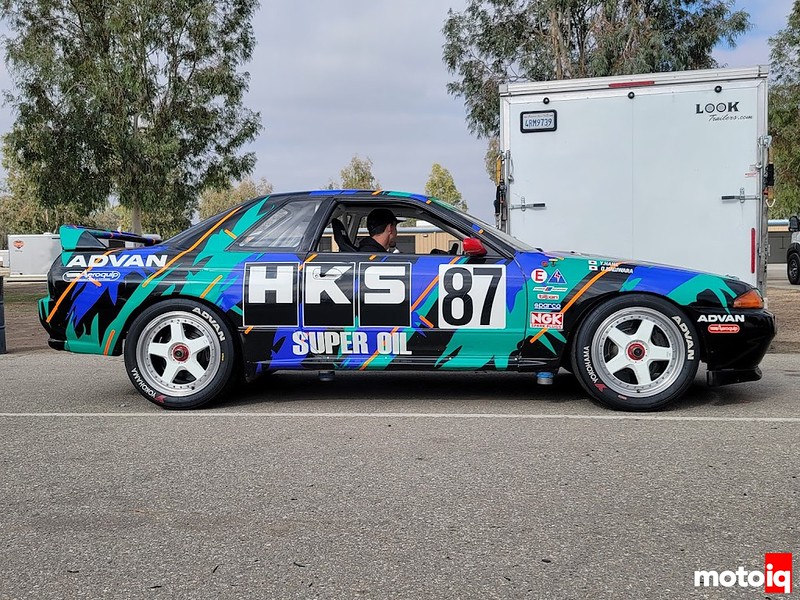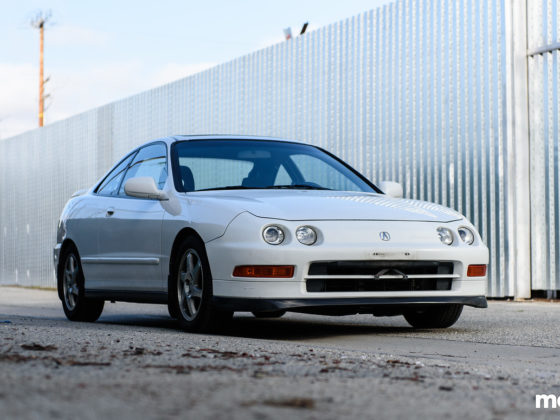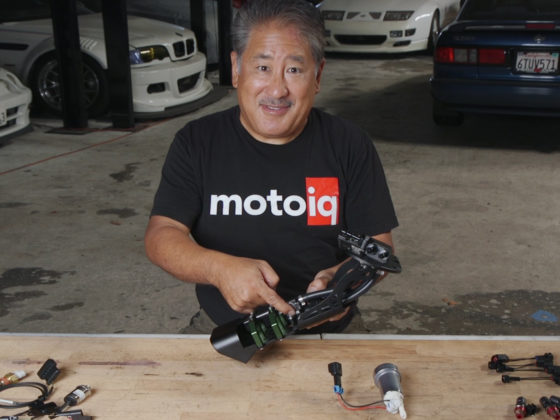
The rear brakes are also AP instead of Alcon. 4-piston calipers with 305×25.5mm rotors. The car uses a dual master cylinder system with an adjustable balance bar. There is no brake booster or ABS system. The wheels are 18×10 Impuls with 265/680-18 Yokohama Slicks.

The interior is pretty straightforward. You can see the adjustment know for the brake bias on the right side of the dash. The factory cars had switchable programs for the ATTESSA AWD system’s torque bias but I didn’t see these knobs on the HKS car. The different from stock gauges are for the engine oil pressure and temperature as well as the transmission temperature I believe. Group A rules say the stock dash and door panels must be maintained so you can see the stock door panels here.

The digital displays are for the diff and transaxle temperatures. The only ATESSA control switches I could see are the ones that allow you to switch from AWD to RWD manually. The transmission is a six-speed Hollinger with a dual-disc clutch.

A Bride seat is used with only a five-point harness! The Japanese are always behind when it comes to safety.

The cage is typical of Japanese race cars, very minimalistic, there are no crossbars. Actually, I think Group A cage rules at the time were pretty lenient. Also, check out the unsafe and totally illegal nowadays shoulder harness mounts screwed into the rear seatbelt anchors! This car would not pass Drift League tech!




15 comments
Man… as per so many Japanese race cars, there’s a combination of “oh my goodness that’s so cool” and headshaking. I also find it … grimly funny that 2850lbs was a “heavy” race car back then.
Still pretty heavy for a race car.
I mean, I fundamentally agree, but then I look at FIA GT3 where seemingly everything is about that heavy… oh well, “progress”
Bodies in white have gotten 3x heavier due to ever-increasing collision standards. I could easily pick up one end of an S13 shell and move it around but not any new car!
I too really loved production car racing and am a little sad its not still a thing. I bet if it was still a thing, the cars being made nowadays would be a lot more exciting.
*Holinger with one ‘L’
Mike, I echo your sentiment about homologation specials. I just wish we had more cars like the GR Yaris.
As for the BNR32, I’ve always thought the Nismo Group A cars were the top dogs… Until I read about how the Ozzies at Gibson Motorsport tinkered with the GT-R. Apparently the Gibson team explored the possibility of racing against works machinery in Japan, but Nismo effectively banned them from doing so, fearing they might lose face if they lost to foreign competition. Given that Nismo enjoyed a complete monopoly in Japan and supplied all the customer Group A teams with cars, parts and expertise, that does seem like a plausible explanation for why the Japanese and Australian-built cars never met on track.
I remember reading about how the Gibson guys ordered custom-designed ECUs from Electramotive to control both the engine and the drivetrain with a single unit, in much the same fashion as we do today. I then see a photo of a modern-day Japanese time attack car and sure enough, there’s that familiar collection of boost controllers, turbo timers, ATTESA switches, VVT adjusters and the like, all hooked up with a spaghetti wiring loom that’s attached to the bulkhead with cable ties and sticks out from underneath the remnants of an OEM dashboard… It’s almost as if it’s a prerequisite and a tradition passed down from generation to generation, beginning with the BNR32 and its contemporaries.
Not even in the same league as the Australian Gibson motorsport Group A gtr’s.
http://www.speedhunters.com/2013/02/godzilla-attacks-the-gibson-group-a-gt-r/
Thanks for sharing Mike, seeing these and the Aussie GT-Rs tearing up the competition had a very formative influence on young me and no doubt played a big factor in my being a Nissan tragic ever since.
Regarding the bodywork, I believe all production GT-Rs had aluminium fenders and an aluminium hood. This is certainly the case for my “base model” BNR32 but who knows if those parts had been swapped out over the years. They do match the condition of the rest of the car though, so I’m fairly confident the car left the factory with them.
They do but the Nismo versions supposedly had lighter versions.
It’s a bit unfair to compare the AU vs JP Group A cars. The Japanese cars had no competition and all of the cars in their class were identical so they didn’t need to go to the lengths that Gibson did. There were some cool bits NISMO homologated for the JGTC cars like Carbon Brakes and water cooled calipers which weren’t really seen elsewhere for another 3-4 years or so (besides F1).
Your comment about fuel pumps made me chuckle. Working in the marine industry it was quite a thing when we learned that Yamaha came out with their 425hp V8 outboard with 5(!) fuel pumps a few years ago. Granted it is direct injected. For comparison Mercury’s new 600HP V12 outboard uses a single lift pump paired with a single high pressure pump, but it only has lowly port injection.
Very cool write up on a very cool car, I remember seeing adds with this car in my favorite mags (what are those?) when I was just getting into modifying cars in my teens!!
You can see the HKS ETC which is their electronic torque controller where the rear seat would be. Normally you would see a control on the dash. Not sure if its up there somewhere. The engine is a Reinik Group A by the fuel rail and the water pump pulley. Its interesting HKS did some of their own things, but not their own fuel rail, and some other parts. Sort of an interesting mix.
Great article about an awesome car….but Mike it’s time to return to Group A school for a refresher course……
All the body kit additions were originally homologated for Group A on the 1990 Nismo version. It’s internet myth that has seen them labeled N1.
That’s an HKS ETC torque split controller in the back not a VPC. The silver tank also looks like a dual chamber Lifeline extinguisher rather than an air jack accumulator.
Intake manifold is stock as per Group A regs, as is the intercooler.
I didn’t think it was a fire bottle because the plumbing didn’t look like what is typical, too large, and there was no typical pressure gauge, valve, actuation cable, or solenoid and I didn’t remember seeing discharge nozzles.